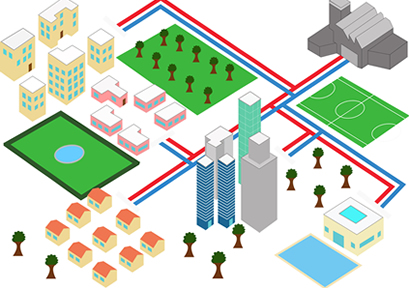The district heating systems or centralised heating networks
The central heating networks allows the supply of thermal energy to a large number of buildings from one or several heat production sites.
The distribution is carried out by an underground insulated pipes that transport the thermal liquid (hot water) to the buildings. Accordingly, each user may individually use the desired thermal service.

Generally speaking, a DH system is composed by the following elements:
- Heat production plant, where the thermal energy of the system is generated by means of one or several heat production elements (boilers) with their corresponding filter equipment for the maximum reduction of emissions into the atmosphere.
Generally speaking, accumulation deposits or buffer tanks are installed which improve the general performance of the installation.
- Distribution network in order to transport the energy generated at the heat production plant to the consumption points, with minimum energy losses in order to achieve the maximum efficiency of the system.
- Thermal substations, situated at each one of the consumption points which are serviced by the system. The substations are formed by heat exchangers and meter and regulation devices for the transfer of energy from the distribution network to the building or the existing heat production plant.

In the majority of cases, these systems are managed by means of energy sales mechanisms. An energy services company exists which manages the installation and charges users in accordance with their energy consumption, resulting in a reduction of the energy bill.
Directive 2009/28/EC in relation to the promotion of the use of renewable energy sources encourages the use of the above installations and considers that it is necessary to establish mechanisms in order to promote urban heating and cooling systems based upon renewable energy sources by Member States.







